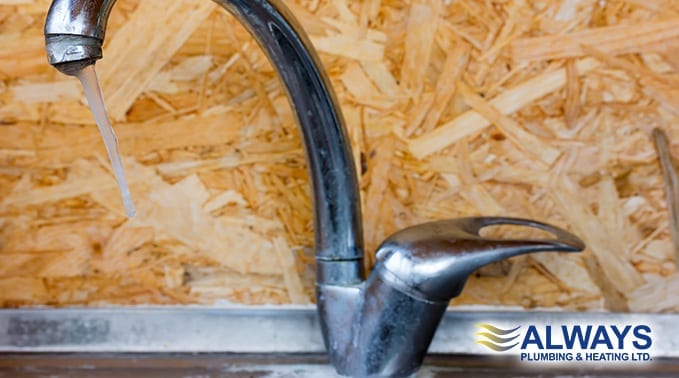November has arrived and with it, Old Man Winter. As temperatures continue to drop over the next couple of months homes in the Edmonton area will be at a greater risk of frozen pipes. Uninsulated pipes can freeze when temperatures reach just -6 degrees Celsius. Without the necessary precautions taken, pipes in the Edmonton area are susceptible to freezing throughout the Winter and into early Spring. Pay attention to pipes that are uninsulated or on exterior walls. They are more exposed to the elements giving them a higher risk of freezing.
How To Keep Your Pipes From Freezing
- Let warm water drip from the faucet furthest from the main water line overnight. This will ensure water runs throughout the pipes in the house.
- Keep your thermostat set to the same temperature at night that it is during the day.
- When traveling keep your heat on and your thermostat set between 13-16 degrees Celsius. Have someone check your pipes regularly for water flow.
Even if you take every precaution, pipes can still freeze in severely cold temperatures like we experience in the depths of winter. Waking up to frozen pipes is a dreadful thing. It can be difficult to immediately know what, if any, damage has already been done until the pipes are thawed.
The good news is, frozen pipes don’t have to mean burst pipes. If you suspect they may be frozen, check them first thing in the morning. If they are, start acting immediately. The longer the pipes stay frozen and the ice is allowed to expand, the more stress and potential damage to your pipes.
4 Signs That Your Pipes Are Frozen
- One or more exposed pipes are wet or have a frost-coated waterline.
- A bulge in the pipe where water has frozen into ice.
- Water either trickles or won’t flow at all from one or more faucets.
- Your toilets aren’t refilling following a flush.
If you notice one or more of these signs after a night of below freezing temperatures, your pipes have frozen. Do not wait to thaw your pipes. The longer they stay frozen, the more likely one is to burst. Take these steps to safely thaw your frozen pipes and minimize pipe or water damage.
How To Thaw Frozen Pipes
Step 1: As soon as you notice your pipes are frozen, turn off the water supply to that section of the house, or the whole house if multiple pipes are affected.
Step 2: Turn on the faucet and leave it open. Running water through the pipe will help it thaw.
Step 3: Locate the frozen area. If you can’t locate the frozen area or it’s not accessible, call a professional as soon as possible.
Step 4: Once you’ve identified the frozen area, apply heat to sections of the pipe. Start at a section of the pipe closest to the faucet. As one section thaws, work your way towards the coldest section.
An electric heating pad, electric blow dryer, space heater, hot wet towels or electrical heating tape can be used to apply heat. Check for standing or leaking water before using anything electric and do not leave it unattended.
Step 5: Continue applying heat until water pressure is fully restored.
Step 6: Once the pipe is thawed, check all of them. If one freezes then others may have too.
Step 7: Check for a burst pipe.
Signs of a Burst Pipe or Water Leak
- Dripping sound within the walls.
- Puddles on the ground or under cabinets.
- Water damage on the ceiling walls.
- A decrease in water pressure.
- Fluctuations on the water meter when your main water line is shut off.
Most frozen pipes can be thawed, damage free, if caught in time. If you think a frozen pipe may have burst in your Edmonton home, call Always Plumbing and Heating today at780-489-8118 (Edmonton) or 587-601-1253 (Fort McMurray). We provide emergency service 24 hours a day, 365 days a year.

